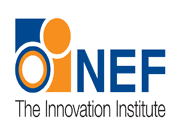Innovisions 2012 – Answering the question: What does Innovation mean to you?

NEF: The Innovation Institute Conference Innovisions 2012 held on 5 Dec, in association with EDF Energy Campus, was a cavalcade of the latest ideas, technologies, and practices. Around 200 educational and business leaders heard world class innovators give their perspectives and insights into what innovation meant to them.
Alongside this, eight winners from business, education and public sector received awards from BBC presenter and Teen Tech CEO Maggie Philbin for outstanding shows of innovation, including Baroness Sue Campbell of Loughborough, Chair of UK Sport who received an award for the Most Inspiring Innovation Leader.
Kicking off proceedings with NEF’s newly published research report, Open Innovation in STEM Learning, which advocates a new innovation in the STEM learning model, Professor Sa’ad Medhat, NEF CEO said: “The T-Shaped skillset is increasingly in demand by employers, and these are often met only through industrial apprenticeships and in-house training by companies. The report has provided a framework that will enable educational institutions to remodel their programmes to deliver contemporary technical and scientific vocational education that meets with the needs of learners and society at large.” The report featured a Foreword from Sir Richard Branson, Founder of the Virgin Group, who stated: “It would be wonderful if students emerged, especially from vocational training, with technical know-how but also a good appreciation of business skills and personal behaviours needed for success. Some colleges will need to fundamentally rethink their approach and curriculum but I hope this report gives a wider understanding towards making these changes.” On being innovative, Branson cited a maxim used in Virgin: “Don’t just play the game, change it for good!”
Looking at innovation globally, the Rt. Hon Patricia Hewitt Senior Independent Director, BT and former Secretary of State for Trade and Industry, described how innovation in India has helped to end preventable blindness through reengineering a previously expensive process leading to a high quality service delivered at a fraction of the cost. Mrs Hewitt said ‘frugal innovation is happening all the time in India as a way of life. Known as jagard, it has greater meaning than just doing more with less, and it is out of this cauldron of chaos and creativity come these wonderful solutions, and helps to keep India leading edge.”
Chief Executive of the reborn Plessey Semiconductor, Michael Le Goff took everyone on a journey of their latest innovations, low cost LEDs and EPIC (Electric Potential Integrated Circuit) Sensors, explaining how both products are helping to change the world of health, transport, and communications, with such applications as bed sensors to take ECG readings instantly , driver alertness sensors monitoring biometric data notifying a driver before they fall asleep at the wheel, and lap top & Smart phone proximity sensors, so with the sweep of the hand through the air, a device can be switched on or applications invoked. Micheal added: “Plessey are innovating constantly to radically enhance the human experience with micro-electronics solutions enabling you to achieve more than you thought possible. Competition creates the innovative spirit and drives us forward to succeed.”
In an unprecedented line up of business champions, the Innovation in Business inquiry, chaired by New Scientist’s Jeremy Webb, sought to answer questions on the bureaucratic nature of R & D, instilling innovative cultures, and interpretation of market intelligence for innovative gain.
On cultures of innovation, Julian Hellebrand, from Cobham, a company that has acquired around 50 smaller companies, stated “acquisition often brings cultural differences; the goal is to reduce this by establishing value in face-time. In our connected ‘email obsessed’ world’ face to face is the best way to get to know people, and unleash their creativity and innovative energy.”
Tony Moloney from National Grid had a different take on driving innovation internally, explaining the importance of building innovation from the small improvements to the big innovations, termed in National Grid “Little I – Big I”. Tony added that, “creating curiosity in people was essential, having the confidence to try something new, and build resilience by learning from failure – all ingredients in instilling an innovative culture”.
Big data is always talked about, but how can it be used innovatively? This question, put to the panel, started the synapses sparking. Mike Pilbeam, Director, EMC2 responded: “companies store massive amounts of data for regulatory reasons, but some have wised up to the opportunities in exploring the data, connecting to real time information such as social media, using systems that analyse 100 times faster than before and innovating from what they see and hear. It’s a case of listening to what the customers saying and comparing the sector horizon scan – looking in the front and rear view mirrors simultaneously!”
Asked about their latest innovation, DuPont’s Mark Young described “their research into bio-source materials development – a drive to move from oil-based products to other materials.” With a $2Billion R & D budget, Marc was questioned on R & D pressured, he stated the need to “balance the R and D investment with a wide portfolio of short, medium and long term projects -short term to meet shareholder need and a longer term strategic viewpoint to ensure the company stays ahead.”
On their R & D practice, Microsoft’s Rob Fraser said: “If the failure rate is too low, the company isn’t taking enough risk, so that means we’re achieving too much and not pushing the boundaries as much as they should.”
The Innovation in Education inquiry, chaired by the Telegraph’s Julie Henry, lead on how innovation can be driven in the educational system. Prof Penny Sparke, Kingston University stated that “use of pedagogic techniques from Art and Design could be used to engender a culture and practice of innovation and creativity”.






Responses